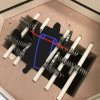I'm sorry, but I was raised to say what I think and know, not what someone wants to hear from me .The folded end of a foil packet will hang perfectly fine Natlek. No need for a special cage.
Try to be a bit more optimistic and less contrary. A few less, "Why do you do that?" posts would help.
You never tried that my friend .I mean on your * U * idea . You just offered a solution without thinking a little deeper about it . Do you know how I know? Because I tried it! I have that foil and I try in my tube furnace many ways to hang envelope with blade inside .I did not like any of them ! Just think what will happen if it accidentally falls and Damacore of 500 euros is inside ........No way !
My vacuum/argon oven is almost finished, I'm just waiting for some electronics. I thought for a long time how to make it . I decided on a vertical one. So when I open the door, the argon will not leak out . So for my argon oven I build two *racks* from 3.2mm Kanthal wire .One for 4 stainless steel blade in envelope and one for 10 carbon steel which I will quench all at once .
Now back to topic , I have some words to say about math /not physics / this time .If this is oven in question seems that that ceramic rods are about 12mm Dia ? let say that wrapping foil 4-5 times around rod work perfect . That would be how much ? About six inch extra length of foil ? After 100 knives you spent 15 meters foil extra ? Rest of math do for your self ,how much that will cost .With rack you will do *clean* and *safe* job every time without wondering if Damacore is *hanging* inside or has fallen and rest on wall and HT elements .
Have a good day !
I am done with this topic , we are all adults and free to do as we like .

And make sure that this long ceramic rod does not burn your hands when you handling it with wrapped foil .
Last edited:

